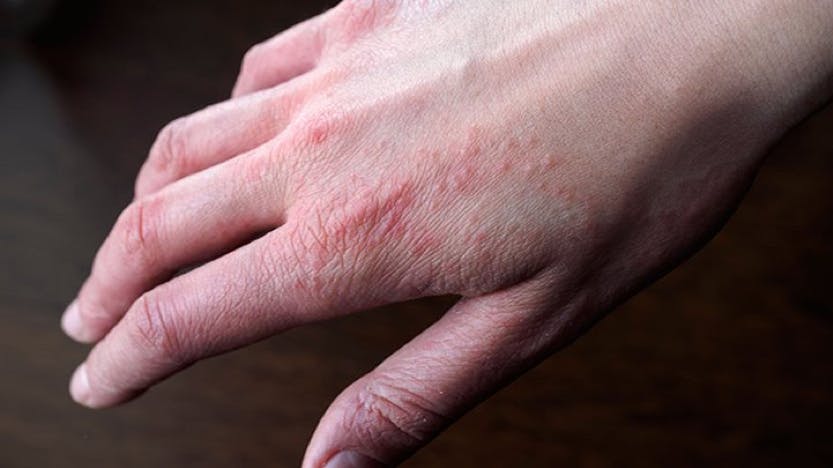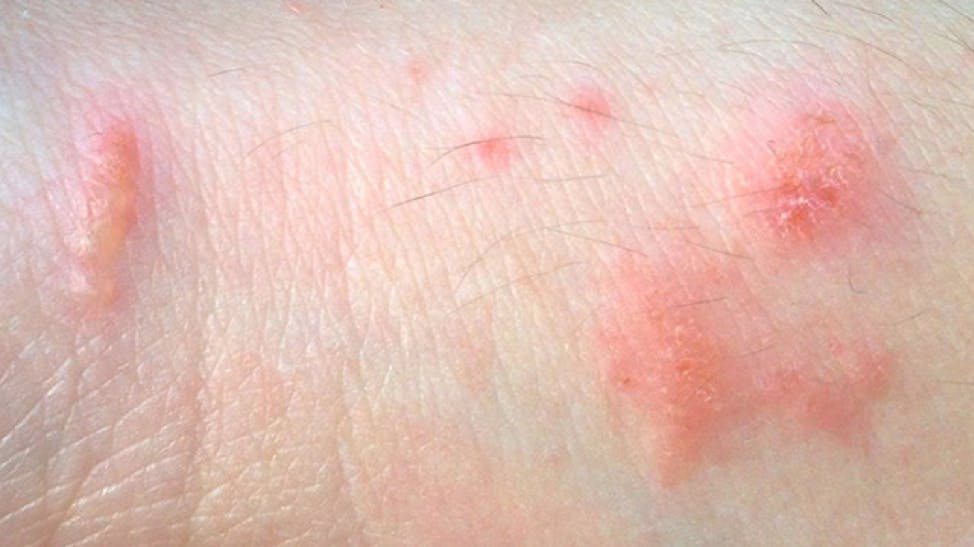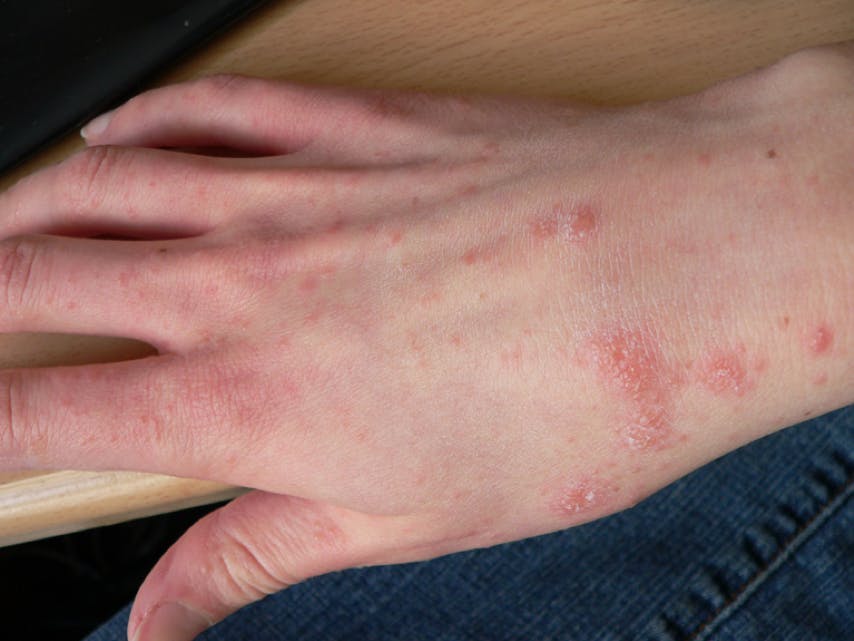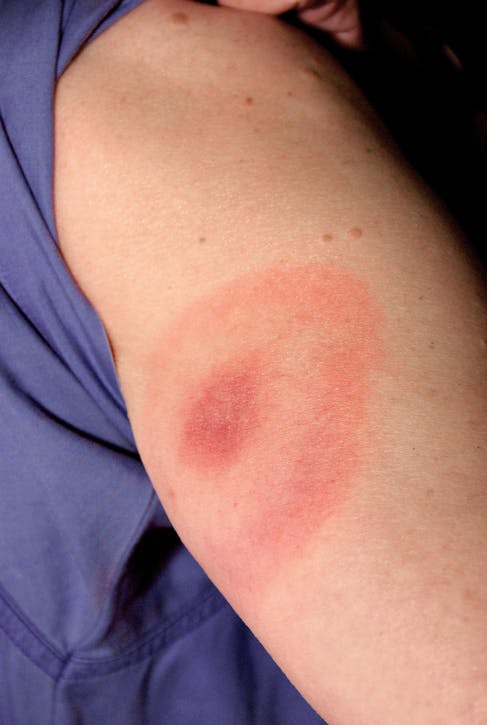Pictures of Different Poison Rashes
No one wants to scratch an itch only to discover that a red, bumpy rash has cropped up, but the truth is that we're all bound to get a rash at some point or another.
Luckily, rashes are common occurrences and can be treated relatively easily with the right knowledge and care.
Here, we'll show you some of the most common types of rashes, how you may be able to treat them at home and when you should see a doctor.
Most Common Rashes
Here are some of the most common types of rashes and what they look like:
Eczema
Atopic dermatitis, also known as eczema, is a non-contagious skin condition that's characterized by itchy, red and dry skin. According to the National Institute of Allergy and Infectious Diseases (NIAID), eczema affects nearly 30 percent of the U.S. population.

Source: Everyday Health
Unfortunately, eczema isn't curable, but it is treatable. For many, the most effective short-term treatment is applying an anti-itch cream or a rich moisturizer and/or taking an oral allergy medication.
For eczema sufferers who can't find relief through at-home methods, more powerful prescription topical and oral medications exist, such as hydrocortisone cream and Diphenhydramine (Benadryl), respectively.
If the patient's affected skin has contracted a secondary infection, antibiotics may also be necessary (click here to learn more about antibiotics and when they should and shouldn't be used).
Poison Ivy, Poison Oak and Sumac Rashes
Poison ivy, poison oak and sumac are plants that can cause redness, blotchy spots, itching, blisters and/or swelling upon contact.

According to Mayo Clinic, poison ivy, poison oak and sumac rashes are caused by uroshiol, an oily resin that coats the plants.
Although washing your skin immediately after exposure can help reduce your risk of getting a rash, the uroshiol's oily nature can make it difficult to wash off.
Over-the-counter washes designed to target uroshiol can be purchased at drugstores, but if you're not able to use such a wash before the rash sets in, there's little you can do besides treating the worst of the rash's symptoms.
To soothe poison ivy, poison oak and sumac rashes, many turn to non-prescription anti-itch creams, which can help reduce itching. Other home treatments include cold compresses and oatmeal baths.
People with severe rashes, blistering and swelling should see a medical provider and may be prescribed with a topical treatment.
Scabies
Unlike superficial rashes, scabies is caused by microscopic burrowing mites that infest and lay eggs in the outer layers of the skin.

According to the Centers for Disease Control and Prevention (CDC), scabies is usually spread through skin-to-skin contact with infected persons. Its most common symptoms are severe itching and a pimple-like rash, though tiny burrows can sometimes be seen with the naked eye.
Scabies is far from uncommon — the American Academy of Dermatology states that there are millions of cases worldwide each year.
Scabies mites can live for up to two months in a person's skin, so scabies rashes won't simply go away on their own in a short amount of time.
Currently, the only treatment for scabies is a topical prescription which must be obtained through a medical provider — no over-the-counter treatments exist.
Psoriasis
According to the National Psoriasis Foundation, psoriasis is a non-contagious skin condition that's characterized by a red, bumpy and/or scaly rash.

Psoriasis rashes are often accompanied by burning, itching and stinging sensations. There are several types of psoriasis, with the most common being plaque psoriasis, which is identifiable by its silvery-white, dry and itchy rashes.
For mild cases of psoriasis, over-the-counter moisturizers, ointments and creams can provide relief.
For more severe cases, or for a particularly bad flare-up, prescription-strength topical and oral medications can be provided by a medical provider.
Tick Bites
Ticks are small, bloodsucking parasites that populate every U.S. state in the form of one or more species, according to the CDC. Tick bite rashes can appear as a small red dot or can grow to resemble a large red bullseye.

Since ticks burrow their head into the skin of their host, they will remain attached until they are engorged with blood or forcefully removed. The CDC recommends removing ticks with a pair of fine-tipped tweezers, taking care to apply steady, even pressure without twisting or jerking. Directions are here!
Improper removal can cause the tick's head or mouthparts to remain embedded in the skin. If those can't be removed with tweezers, it's necessary to seek medical attention to avoid an infection.
Red bullseye-shaped rashes like the one in the image above can be an indication that the tick has transmitted Lyme disease, a disease which can cause both short- and long-term symptoms such as fatigue, headache, chills, swollen lymph nodes and other flu-like symptoms.
To treat early-stage Lyme disease, patients are typically prescribed oral antibiotics, while late-stage Lyme disease can be treated with intravenous antibiotics, according to the Canadian Lyme Disease Foundation. No over-the-counter treatments for Lyme disease are currently available.
Seasonal Rashes
Although rashes can appear at any time of year, some are more frequently seen during some seasons than others.
Here are the most common rashes for each season, some of which we've covered in this article:
Winter
- Eczema
- Psoriasis
Spring
- Lyme disease
- Poison ivy, oak and sumac
- Heat rash, a red, blistery rash that's caused by trapped sweat.
- Polymorphous light eruption, a raised, bumpy rash that's caused by exposure to sunlight in some people.
- Drug-induced photosensitivity, which occurs when a drug combines with sunlight to produce irritation or an allergic reaction.
- Pityriasis rosea, a patchy, widespread rash that can linger for months.
Summer
- Lyme disease
- Poison ivy, oak and sumac
- Heat rash
- Polymorphous light eruption
- Hives, an outbreak of swollen, red and itchy welts that form in response to an allergen or irritant.
- Allergic reactions, such as hives, nasal congestion, sneezing and more.
- Eczema
- Chronic rashes
- Insect bites and stings, such as mosquito bites or bee stings.
- Swimmer's itch, a rash caused by burrowing parasites that are found in warm bodies of water.
- Drug-induced photosensitivity.
Fall
- Hives
- Allergic reactions
- Eczema and psoriasis
- Pityriasis rosea
When to See a Medical Provider
Though some rashes can be successfully treated at home, it's important that you recognize the signs of a rash that needs medical attention.
You should see a medical provider if your rash:
- Is covering all or most of your body.
- Came on suddenly and spread rapidly.
- Is accompanied by a fever or flu-like symptoms.
- Begins to blister.
- Is causing pain.
- Appears to be infected.
- Is shaped like a bullseye.
- Isn't showing signs of improvement after a few days.
- Is unresponsive to over-the-counter treatments.
- Is accompanied by symptoms of a severe allergic reaction, like difficulty breathing or severe swelling.
- Is accompanied with an uncontrollable itch, as this can lead to infection.
An ongoing rash can also be an indication of a chronic skin condition and should be examined by a medical professional.
If you have a rash that needs medical attention, or simply want to treat your rash fast, our providers are here to give you the relief you need.
You don't have to wait out an uncomfortable rash — a quick visit to your local GoHealth Urgent Care center will scratch that itch right away.
*Disclaimer: This information is not intended to serve as medical advice. Please visit your local GoHealth Urgent Care center to receive a proper medical diagnosis for your rash.
Health news and tips for the whole family
Stay on top of your health
Get seasonal tips and tricks
Recipes to keep your family healthy
Subscribe to newsletter
By providing your email address you agree that GoHealth Urgent Care and our health system partner may contact you in the future. Your privacy is important to us; view our Privacy Policy.
Pictures of Different Poison Rashes
Source: https://www.gohealthuc.com/library/common-rash-pictures
0 Response to "Pictures of Different Poison Rashes"
Post a Comment